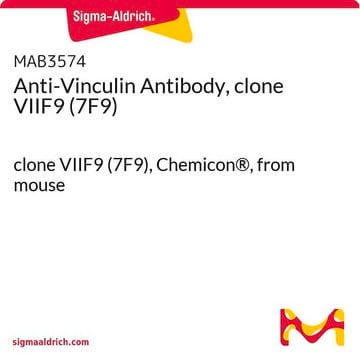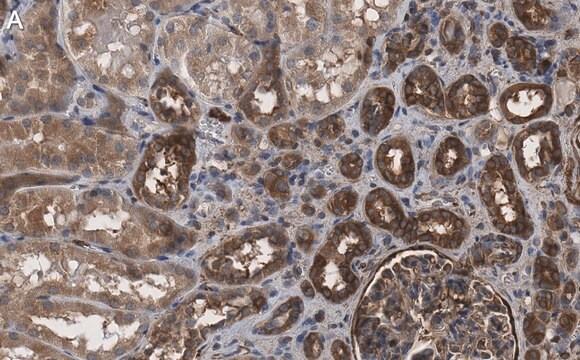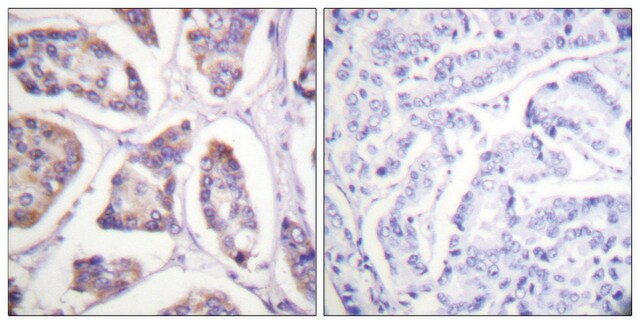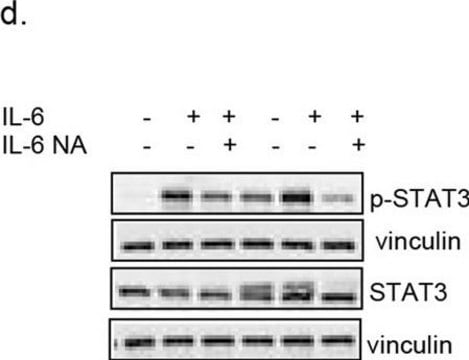There are no available papers that cite using clone VIN-11-5 with Drosophila vinculin. The specific epitope for this antibody has not been mapped. However, there is a paper that maps the epitope binding area of this antibody clone - JBC 266, 8734-8740. 1991, Fusun Kilic, et al. --> "Hence the epitope lies between cysteines 545 and 737." Please see the link below to review this publication:
https://www.sciencedirect.com/science/article/pii/S0021925818315072?via%3Dihub
V4505
Anti-Vinculin Antibody
mouse monoclonal, VIN-11-5
Synonyme(s) :
Vinculin Antibody Sigma, Anti-VCL
About This Item
Produits recommandés
Nom du produit
Monoclonal Anti-Vinculin antibody produced in mouse, clone VIN-11-5, ascites fluid
Source biologique
mouse
Niveau de qualité
Conjugué
unconjugated
Forme d'anticorps
ascites fluid
Type de produit anticorps
primary antibodies
Clone
VIN-11-5, monoclonal
Poids mol.
antigen 116 kDa
Espèces réactives
bovine, human, chicken, mouse
Technique(s)
indirect immunofluorescence: 1:50 using cultured chicken fibroblasts
microarray: suitable
western blot: suitable
Isotype
IgG1
Numéro d'accès UniProt
Application(s)
research pathology
Conditions d'expédition
dry ice
Température de stockage
−20°C
Modification post-traductionnelle de la cible
unmodified
Informations sur le gène
human ... VCL(7414)
mouse ... Vcl(22330)
Catégories apparentées
Description générale
Spécificité
Immunogène
Application
- western blotting.
- immunofluorescence.[1]
- immunocytochemistry.
Actions biochimiques/physiologiques
Autres remarques
SAB4200729 Anti-Vinculin antibody, Mouse monoclonal
clone VIN-11-5, purified from hybridoma cell culture
Clause de non-responsabilité
Vous ne trouvez pas le bon produit ?
Essayez notre Outil de sélection de produits.
En option
Code de la classe de stockage
13 - Non Combustible Solids
Classe de danger pour l'eau (WGK)
WGK 1
Point d'éclair (°F)
Not applicable
Point d'éclair (°C)
Not applicable
Faites votre choix parmi les versions les plus récentes :
Certificats d'analyse (COA)
Vous ne trouvez pas la bonne version ?
Si vous avez besoin d'une version particulière, vous pouvez rechercher un certificat spécifique par le numéro de lot.
Déjà en possession de ce produit ?
Retrouvez la documentation relative aux produits que vous avez récemment achetés dans la Bibliothèque de documents.
Les clients ont également consulté
-
Hello! Has it been published or predicted if this antibody will react with Drosophila vinculin? Or, could you provide where in the human vinculin this antibody interacts?
1 answer-
Helpful?
-
Active Filters
Notre équipe de scientifiques dispose d'une expérience dans tous les secteurs de la recherche, notamment en sciences de la vie, science des matériaux, synthèse chimique, chromatographie, analyse et dans de nombreux autres domaines..
Contacter notre Service technique
















